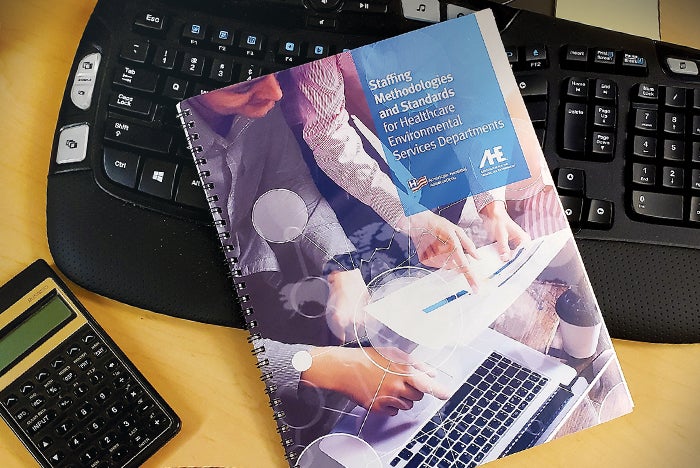Staffing methodology helps to optimize ES workforce utilization

Image courtesy of AHE
Environmental services (ES) staffing standards is one of the most requested topics for education by members of the Association for the Health Care Environment (AHE).
Many organizations, such as benchmarking providers and outsource-management companies, use standards they have developed in regard to ES staffing. Other international organizations have developed their own standards. Each of these different voices in the field represents a staffing standard for cleaning, but there are widely varied foundations for establishing those standards.
As a result of these concerns, AHE set out to provide its members with a clear and measurable process for understanding the staffing methodology of ES departments.
This methodology includes metrics derived from AHE member-staffing standards practiced in the field as well as direction from experts who have spent their careers honing the craft of ES staffing. It served as the basis of AHE’s Staffing Methodologies and Standards for Healthcare Environmental Services Departments book, from which this article is excerpted.
Building an inventory
The most important data needed when developing a staffing analysis standard for a hospital is the square-footage inventory for the facility. Just knowing the square footage of the space is not enough. Cleaning intensity and frequency, and thus productivity, will vary according to space type. For example, cleaning patient rooms requires more time than cleaning office space of the same size.
Computer-aided design (CAD) files or architectural drawings are extremely useful for building such an inventory. They can provide accurate square-footage information needed to calculate staffing needs. A facility or engineering director can be a good resource for obtaining these drawings. If they are not available, hand-drawn maps and a detailed list of each room and space type will suffice.
ES professionals will need a laser measuring device that can quickly and accurately obtain the square footage measurements. For each room on the list, they should measure the square footage and note the space type (e.g., patient room, nurses’ station, medication room or utility room).
If there are multiple rooms or spaces of the same size and use type, ES professionals can measure them once and count the number of rooms to get the net cleanable square feet (NCSF) of all spaces combined. The facility space inventory records will be useful in developing accurate task lists for staff to check off as they finish cleaning areas.
Gathering this information is the most time-consuming component of the process. It is detailed work, especially if CAD or architectural drawings do not exist. However, once it is completed, an ES professional will have one of the key pieces to establishing accurate staffing outcomes.
Space inventory has sometimes been referred to as “unitizing.” The Oxford Dictionary definition of unitizing is to “form into a single unit by combining parts into a whole.” The concept of unitizing is similar to creating a space inventory. Specifically, it is identifying the type and size of space within a facility and then combining all of the various segments of the facility into one document that can be used to drive workflows and staffing levels.
The staffing analysis
Once an ES professional has the space inventory, he or she is ready to build a staffing analysis for the facility. To do this, he or she will break the analysis out into different sections:
- Directly proportional staffing. This can be used where cleaning of areas is directly proportional to size or square footage of the area. The larger the area, the more worked hours are required to clean it. A productivity standard is expressed in the nomenclature of “square feet per worked hour” (standard = square feet/worked hour). To use directly proportional staffing requires knowledge of the amount of square feet to be cleaned from the space inventory collected earlier.
- Linearly related staffing. This represents areas where the cleaning time is related or linked to the square footage, but not directly tied to square footage. This is the largest category of space types from which to calculate worked hours. To identify the quantity of worked hours required to clean these categories, the square footage of the identified space and the number of individual rooms for which staffing is being calculated are plugged into an equation. To calculate linearly related staffing requires knowledge of the number of square feet to be cleaned from the space inventory collected earlier.
- Not-related staffing. This represents cleaning areas that are not related to the square footage. In the surveys conducted, these categories of space are identified as not related to square footage. For example, no matter the square footage of the patient room, surveyed cleaning times did not show that square footage was the modifying factor for worked hours. Thus, time was a better determining standard than square feet. To identify the quantity of worked hours required to clean these categories, simply multiply the cleaning time by the total number of similar rooms, remembering to convert the number of minutes to worked hours by dividing by 60.
Combining staffing metrics
No single metric or benchmark will provide an accurate one-size-fits-all staffing solution. Various aspects of staffing will be critical to achieving productivity efficiency. They include:
- Volume-adjusted staffing. ES departments can no longer staff simply based on the square footage of the facility. Health care staffing today has to be flexible and adjust to varying patient volumes of both the inpatient and outpatient environments.
A typical scenario used to be to assign a specific number of patient rooms to staff assigned to inpatient units. If the unit was not full, the technician would use any extra time available to do more in-depth cleaning around the unit. This aspect of the staffing analysis addresses staffing to actual patient volumes and not potential empty square feet.
As identified in the not-related staffing section, cleaning patient rooms is measured by time versus square footage. The equation for calculating the staffing needed for occupied patient rooms is uncomplicated. Simply multiply the number of patient rooms (or total patients calculated in the census) that are occupied by the identified standard.
This same process should be used for each space category listed in the AHE book’s table for calculating not-related space and worked hours. This is only calculating worked hours for daily room cleaning and discharge cleaning so far.
For areas of the hospital that are not listed in any of the tables in the book, ES professionals should consider performing time studies. These measure the time it takes various members of the staff to clean the specific area.
Even though square footage was not used to calculate worked hours for these space categories, it is essential to note the average square footage of each space-category type. This square footage will be removed from the total NCSF of the facility because the cleaning of this space will have already been accounted for with the calculations done in this section.
- Non-volume-related staffing. This represents an all-encompassing title for ES staffing related to cleaning areas that were found to be correlated to square footage or size of the area (i.e., not patient volumes). The category of non-volume-related staffing incorporates both the directly proportional and linearly related classifications.
- Locked-in staffing. This refers to aspects of daily staffing that are required regardless of square footage or volume. Calculating locked-in staffing will be unique to each department and is typically based on the facility’s scope of work. An example of locked-in staffing is the emergency department (ED). It is not uncommon for the ED to require that ES staff one person per shift in the department.
- Formula-driven staffing. Tables provided in the AHE book (i.e., linearly related and square foot-related) identify the formulas necessary for cleaning the associated category spaces. Plugging in square footage and number of rooms provides the worked hours and full-time equivalents (FTEs) required to clean the identified space.
The final process to identify the FTEs needed for cleaning is to calculate the worked hours and FTEs for the remaining square footage not already calculated.
Nonproductive time
When determining the total number of staff required, it is important to include nonproductive labor expenses. The FTEs allocated for nonproductive time will be unique to each department, but the following steps can provide a starting point and guide:
- Relief staff. ES professionals should determine relief-staff requirements to cover sick days, vacation days and Family and Medical Leave Act (FMLA) absences. Typically, staff earn paid time off to cover sick leave days and vacation time. Staff will be required for this time. Sick day usage can usually be obtained through a hospital’s payroll department. The amount of vacation time off may differ among employees based on years of service. The most accurate method to determine vacation coverage is to calculate the days of vacation time each employee earns. If FMLA is utilized to any extent, relief staff required to cover this time will also need to be calculated. Annual data of FMLA usage should be readily available through the payroll department. Every ES department will need to determine its own relief needs based on its staff usage of sick, vacation and FMLA time.
- Managerial and administrative staff. Consideration also must be given to the amount of managerial and administrative staff required for the department’s efficient operation. The number of front-line supervisors needed should be based on a number of factors, including staff experience, training expectations, use of senior or lead staff, the scope of the department’s quality program and patient-satisfaction expectations. Managerial and administrative staff will be dictated by the size and scope of the department.
- Employee paid breaks and employee setup and takedown time. The only staffing time not accounted for at this point is cart setup/takedown, paid break times and nonproductive work time. It is essential to account for these worked hours when identifying staffing for the ES department.
Often, staff are given 15 minutes to get their carts and supplies in the morning and report to their areas ready to work. Likewise, staff are typically given 15 minutes to break down carts at the end of their shifts and bring back soiled linens, mops, rags and other items. This is a total of 30 minutes per staff member working each day.
A first step
Using a staffing and productivity report to calculate staffing for any health care facility is just a first step in the staffing process. It should be used as a tool to help identify individual area staffing standards based on the results of the time study done by AHE members to identify productivity within their own facilities. Each facility will, in reality, be somewhat varied from the survey results.
Staffing correctly is not easy. It takes time and commitment to ensure that the data are as accurate and complete as possible. The reward will be at the end as the Lean takt times are identified for cleaning processes and the ES professional can accurately and confidently hold discussions with the executive team, including finance, to confirm that the staffing is optimal and why any adjustments to square footage and volume will require adjustments to staffing needs.
Rock Jensen is administrative director of support services for Yuma (Ariz.) Regional Medical Center and senior consultant for Soriant Healthcare, Milton, Ga. He can be reached at rjensen@yumaregional.org.



